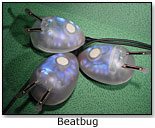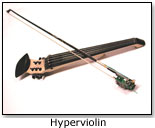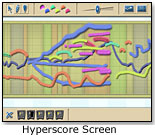
January 1, 2026


Children can sometimes be frustrated by the countless hours of practice needed to play the violin, piano, or other musical instruments. Parents may have had the same experience with musical training in their youth--maybe even quitting before learning to play the instrument well.
Tod Machover, a composer and professor of music and media, and his research team at the Massachusetts Institute of Technology (MIT) in Cambridge, Mass., developed a line of musical toys that can be learned in a very short time--allowing players to achieve a basic level of understanding in three to five two-hour sessions.
The music toys are used in Machover´s Toy Symphony, an international music performance and education project. The project is co-sponsored by MIT Media Consortia Fund, Yamaha, Sega, Fisher-Price, and Mattel.
Toy Symphony music toys developed by the MIT team include: 
"The music toys developed for Toy Symphony help children to have a direct, complete and compelling experience with music so that they can fall in love with music-making first, and become motivated to learn deeper skills later,” Machover said.
 Machover invented Hyperinstruments in 1997. "The original idea was to give live performing musicians the ability to control and shape a vast amount of digital music technology through natural musical skills in a live performance context..." Machover explained.
Machover invented Hyperinstruments in 1997. "The original idea was to give live performing musicians the ability to control and shape a vast amount of digital music technology through natural musical skills in a live performance context..." Machover explained.
"This concept grew over the years, and became a more general technique for enhancing musical expression...from all kinds of musicians, from some of the world´s greatest performers--from Yo-Yo Ma to Prince--to the general public...to kids--in Toy Symphony," Machover added.
Music Improves Learning Skills
Machover said that that there is growing evidence in literature that music is connected to most other forms of learning and that excellence in music-making improves many other skills. According to Machover, "music combines more mental functions than almost any other human activity."
The MIT developed Hyperinstruments and Music Toys to find a "balance between the passivity of the so-called Mozart effect," which Machover says they do not believe in, and the years of traditional instrumental training, "which, while a great discipline, may not fully exercise the musical mind," Machover said.
"Music Toys hit a sweet spot of creative and imaginative discipline and exercise," Machover explained.
Based on this technology, Fisher-Price will begin selling Symphony Painter, a music composition tool, in October. The Symphony Painter will be sold as an “add-on” cartidge to Pixter Color, Fisher-Price’s hand-held digital drawing platform. Using the Symphony Painter, children can convert their Pixter paintings into music. Different colors and strokes create musical elements.
 Machover said that a new version of the Hyperscore will be likely to be released in Fall 2005 and that there are a “number of other inventions in the pipeline.”
Machover said that a new version of the Hyperscore will be likely to be released in Fall 2005 and that there are a “number of other inventions in the pipeline.”
A new school curriculum based on Music Toys, especially in Hyperscore,will be available during the coming year, with full availability in Fall 2005, according to Machover. Machover´s group has worked with large groups of children through the New York City Public Schools, the education office in Mexico City, and Arts bridge, which spans the greater San Diego area.
“We have growing evidence that parents and teachers are very excited by our immersive, hands-on, and creative approach to music education," Machover said, "This interest is growing, and we believe our recent collaboration with Fisher-Price will allow our tools to reach many families.”
Copyright © 2026 TDmonthly®, a division of TOYDIRECTORY.com®,
Inc.